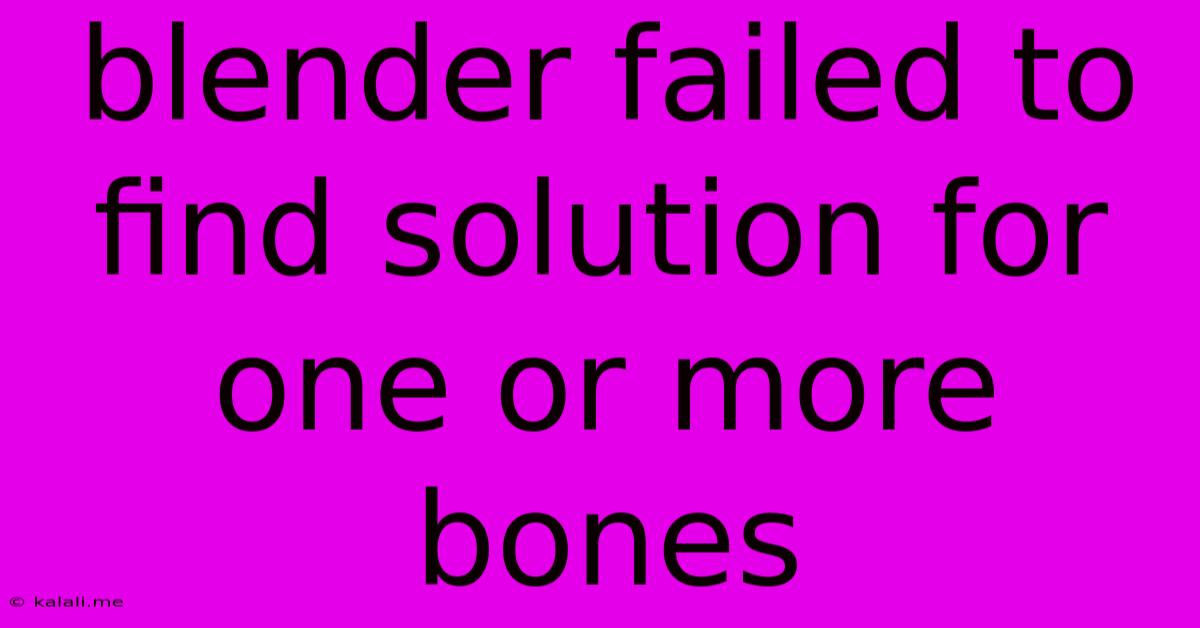Blender Failed To Find Solution For One Or More Bones
Kalali
Jun 07, 2025 · 3 min read

Table of Contents
Blender Failed to Find Solution for One or More Bones: Troubleshooting Guide
Meta Description: Encountering the "Blender failed to find solution for one or more bones" error? This comprehensive guide provides troubleshooting steps to fix this common rigging problem in Blender, covering various causes and solutions. Learn how to identify the issue and get your animation back on track.
This frustrating error in Blender, "Failed to find solution for one or more bones," often pops up during animation or rigging processes. It essentially means Blender's solver (typically used for inverse kinematics or IK) can't find a valid pose for your armature due to conflicting constraints or bone configurations. Let's dive into the common causes and effective solutions.
Understanding the Error
Before jumping into solutions, it's crucial to understand why this error occurs. The problem usually stems from inconsistencies within your armature's structure and constraints. This could include:
- Conflicting Constraints: Multiple constraints acting on the same bone, especially IK and other types of constraints that pull in opposite directions.
- Bone Orientation Issues: Incorrectly oriented bones, leading to impossible joint rotations. This is often missed in complex rigs.
- Bone Parenting Problems: Incorrect bone hierarchy or misplaced parents can cause solver conflicts.
- Bone Limits: Excessively restrictive bone limits might prevent the solver from finding a valid solution.
- Singularities: In some complex rigs, the bone arrangement may create a singularity – a situation where multiple solutions exist, confusing the solver.
- Weight Painting Issues: While less common, incorrectly weighted vertices can indirectly influence bone positioning and contribute to the error.
Troubleshooting Steps: A Systematic Approach
Let's address how to fix this error, progressing from the simplest solutions to more advanced techniques.
1. Check for Conflicting Constraints:
- Inspect Each Bone: Carefully examine each bone in your armature. Select each bone individually and check its constraints in the Properties panel (N). Are multiple constraints pulling in opposing directions? Try disabling one constraint at a time to pinpoint the culprit.
- Simplify Constraints: If you find conflicting constraints, try simplifying them. Can you combine or replace multiple constraints with a single, more efficient constraint? For instance, combine two rotation constraints into one.
- Constraint Order: The order of constraints matters! Reorder constraints to see if that resolves the conflict.
2. Review Bone Orientation:
- Check Bone Orientation: Verify that the bones are oriented correctly and logically within the armature. Use the "X-Axis," "Y-Axis," and "Z-Axis" orientation controls in Edit mode to adjust bone orientations.
- Visual Inspection: Zoom in closely and visually inspect the bones. Any illogical bend or twist? Recheck your modeling process.
3. Examine Bone Parenting:
- Armature Hierarchy: Inspect the bone hierarchy. Is there a logical flow from root to end-effectors? Incorrect parenting is a common source of rigging problems.
- Re-parent Bones (if Necessary): If the parenting is incorrect, carefully re-parent the bones in Edit Mode.
4. Adjust Bone Limits:
- Overly Restrictive Limits: Check the bone limits in the Properties panel. Are the limits too restrictive, preventing the solver from finding a valid solution? Try loosening the limits slightly.
5. Simplify the Armature (If Possible):
- Reduce Complexity: If you're working with a very complex armature, simplify it by temporarily removing or merging bones. This will help to isolate the problematic section.
6. Restart Blender:
- Simple Restart: Sometimes, a simple restart of Blender can resolve minor glitches.
7. Re-create the Armature (Last Resort):
- Clean Slate: If all else fails, create a new armature from scratch. This is tedious, but it guarantees a clean, error-free base for your rig.
Preventing Future Errors:
- Clean Rigging Practices: Develop consistent and clean rigging habits from the start. This includes well-planned bone structures, appropriate constraint choices, and organized bone naming conventions.
- Regular Saves: Save your work frequently. This will minimize data loss if Blender crashes.
By methodically following these troubleshooting steps, you can effectively diagnose and resolve the "Blender failed to find solution for one or more bones" error. Remember patience and careful observation are crucial in resolving complex rigging issues.
Latest Posts
Latest Posts
-
Ansible Core Requires A Minimum Of Python2
Jun 07, 2025
-
Can You Do Me A Solid
Jun 07, 2025
-
Fig Tree In The Bible Symbolism
Jun 07, 2025
-
Can You Stream Movies On Work Computer
Jun 07, 2025
-
How To Steam Tamales Without Steamer
Jun 07, 2025
Related Post
Thank you for visiting our website which covers about Blender Failed To Find Solution For One Or More Bones . We hope the information provided has been useful to you. Feel free to contact us if you have any questions or need further assistance. See you next time and don't miss to bookmark.